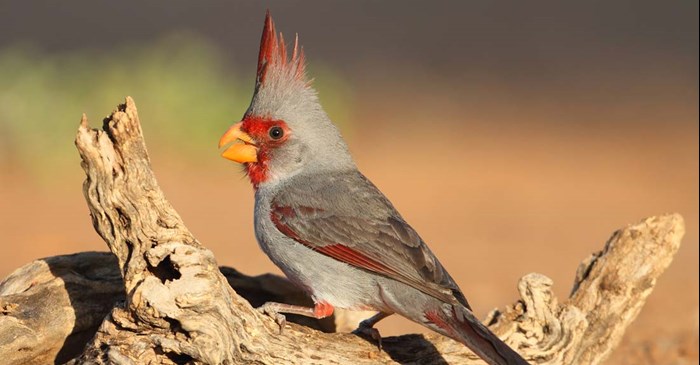In the challenging climate of the desert comes a familiar birdsong that may seem out of place in the scrubby landscape: the sweet, clear, warbling “cheer!” song of the cardinal. Except in this setting, it likely belongs to a close relative of the well-loved Northern Cardinal. The Pyrrhuloxia (pronounced pie-ruh-lock-see-uh) is a gray and red bird found year-round in southern parts of Arizona, New Mexico, and Texas, along with northern Mexico.
In addition to its near-identical song, the Pyrrhuloxia shares several physical features and behaviors of the Northern Cardinal. They’re the same size, they both sport prominent crests, and both are frequent feeder visitors, especially at dawn and dusk. On their gray bodies, the male Pyrrhuloxia sports a bold red stripe that slashes down the breast, along with scarlet accents in the face, crest, wings, and tail.
Pyrrhuloxia is a bird that goes by many names, all revealing something fundamental about its life. Some call it the parrot-billed cardinal and given its stout, thick beak, it’s not hard to see why. Others call it the desert cardinal. But its official name, Pyrrhuloxia, comes from the joining of two Greek words that translate into “scarlet” and “crooked.” Bring them all together for an apt description: The Pyrrhuloxia is a desert-dwelling, parrot-beaked cardinal with scarlet markings.
The Pyrrhuloxia is a tenacious bird and a skilled forager that's well-adapted to the challenging arid climate where summertime temperatures can easily exceed 100 degrees. They can survive weeks without sips of water, getting much of their hydration from insects and plant matter, which includes seeds from weeds and mesquite, as well as berries, wild fruits, and even cactus flowers.
During the summer months, the paired males and females are focused on rearing their young. In early spring males will court females with soft wing fluttering, head bowing and food offerings. Females build neat, compact nests, camouflaged in brushy areas, lined with rootlets and horsehair, while males sit on high perches, cranking out their clear, warbling “cheer cheer” songs, ready to chase off rivals when they get too close. As autumn approaches, the intense nesting-season rivalries fall away, and the birds form large foraging flocks that can number as high as 1,000 birds.
To enjoy these beautiful victors of the desert up close, draw them in for a landing with a mix that’s packed with large seeds and none of the fillers they’ll throw aside. Lyric Cardinal Mix features black-oil sunflower seed, safflower, black-striped sunflower seed, and buckwheat.
